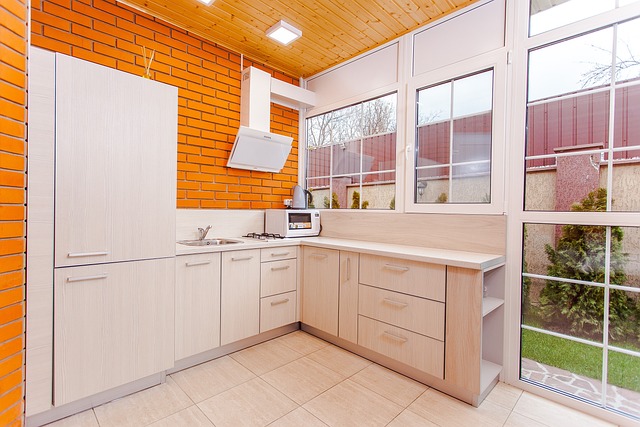A kitchen remodel focused on energy efficiency combines smart technology and eco-friendly features to reduce carbon footprints. Upgrading to LED lighting with motion sensors, energy-efficient appliances, strategic natural light, and smart home technology minimizes energy waste, lowers utility bills, and contributes to a greener lifestyle. Integrating these elements results in an aesthetically pleasing kitchen that supports environmental stewardship while delivering superior performance. Keywords: kitchen remodel for energy efficiency, eco-friendly kitchen upgrades, sustainable kitchen renovation, energy-saving kitchen appliances, green kitchen remodeling, low-energy lighting for kitchens.
Looking to reduce your carbon footprint and lower utility bills? Consider a kitchen remodel focused on energy efficiency. In this comprehensive guide, we explore the benefits of incorporating motion-sensor lighting as part of an eco-friendly kitchen upgrade. From understanding the technology behind these green alternatives to providing a step-by-step installation guide, we’ll show you how to make your kitchen more sustainable without compromising style or functionality. Discover the long-term savings and positive impact of energy-efficient kitchen design and appliances.
Understanding Motion-Sensor Lighting: The Green Alternative
Motion-sensor lighting is a smart and innovative solution that has gained popularity as part of a sustainable kitchen renovation. This eco-friendly kitchen upgrade offers an efficient way to reduce energy consumption while maintaining functionality. By automatically turning on lights when motion is detected, these sensors ensure that illumination is provided only when needed, eliminating wasted energy from unused spaces. This simple yet powerful feature makes it an ideal choice for those seeking a green kitchen remodeling approach.
In the context of a kitchen remodel for energy efficiency, integrating motion-sensor lighting can significantly contribute to an energy-efficient kitchen design. It reduces the environmental impact associated with traditional lighting methods by minimizing electricity usage. Moreover, combining this technology with energy-saving kitchen appliances promotes a comprehensive sustainable kitchen upgrade. The result is a modern, functional space that aligns with eco-conscious living.
Benefits of Energy-Efficient Kitchen Design
An energy-efficient kitchen design offers a multitude of benefits that go beyond cost savings on your utility bills. By integrating eco-friendly upgrades during a kitchen remodel, homeowners can significantly reduce their carbon footprint. One of the key areas of focus is lighting; low-energy LED fixtures and motion sensors ensure lights only come on when needed, eliminating wasted energy from unused spaces. This simple yet effective strategy not only conserves resources but also enhances the overall ambiance, creating a modern and well-lit cooking environment.
Moreover, incorporating energy-saving kitchen appliances contributes to a greener lifestyle. From efficient refrigerators to induction cooktops, these innovations consume less power while delivering superior performance. When combined with strategic design choices like proper insulation and optimized ventilation, a sustainable kitchen renovation becomes a reality. Homeowners can enjoy a functional, aesthetically pleasing space that aligns with their commitment to environmental stewardship.
Incorporating Low-Energy Lighting: A Step-by-Step Guide
When considering a kitchen remodel focused on energy efficiency, upgrading to low-energy lighting is a smart step. This process involves selecting environmentally friendly fixtures and bulbs that reduce power consumption while maintaining excellent illumination. Start by assessing your current lighting setup and identifying areas for improvement. Replace traditional incandescent bulbs with ENERGY STAR-rated LED (Light Emitting Diode) or CFL (Compact Fluorescent Lamp) alternatives, which use significantly less energy and last much longer.
Next, choose motion sensors to automate lighting control. These devices activate lights only when movement is detected, ensuring that your kitchen doesn’t remain illuminated unnecessarily. Install them in entryways, corridors, and lesser-used areas like pantries. During the renovation, consider integrating smart home technology for advanced control and customization. This can include scheduling light on/off times, setting ambiance lighting, or remotely adjusting brightness from your smartphone. Combining low-energy lighting with these features contributes to a sustainable kitchen renovation, aligning with eco-friendly kitchen upgrades and energy-saving kitchen appliances.
Eco-Friendly Kitchen Upgrades: Beyond the Lighting
In a kitchen remodel aimed at energy efficiency, lighting isn’t just about aesthetics; it’s a significant opportunity to slash unnecessary energy use. Beyond installing low-energy LED fixtures, homeowners can explore motion sensors to ensure lights only come on when needed. This simple upgrade not only reduces electricity bills but also contributes to a greener, more sustainable kitchen environment.
Eco-friendly kitchen upgrades go hand in hand with energy-saving strategies. Incorporating energy-efficient appliances and smart, low-energy lighting for kitchens translates into a significant reduction in the home’s carbon footprint. By integrating motion sensors, you’re taking a proactive step towards a green kitchen renovation, turning your culinary space into an example of modern, responsible living.
Sustainable Kitchen Renovations: Long-Term Savings and Impact
A sustainable kitchen remodel offers more than just a stylish upgrade; it’s an investment in long-term energy savings and environmental impact. By incorporating energy-efficient design elements, such as energy-saving kitchen appliances, low-energy lighting for kitchens, and smart, motion-sensor fixtures, homeowners can significantly reduce their carbon footprint while slashing utility bills.
Eco-friendly kitchen upgrades, from high-efficiency refrigerators to induction cooktops, pay dividends over time. These appliances consume less electricity and water, contributing to a greener lifestyle. Coupled with strategic placement of natural light and energy-efficient window treatments, these renovations transform the kitchen into a beacon of sustainability within the home, setting a standard for both efficiency and style.
Adding motion-sensor lighting as part of a comprehensive kitchen remodel for energy efficiency is a smart, sustainable choice. By adopting eco-friendly kitchen upgrades like low-energy lighting and energy-saving kitchen appliances, homeowners can significantly reduce their carbon footprint while enjoying long-term savings on utility bills. In terms of a sustainable kitchen renovation, these simple changes contribute to a greener lifestyle and a healthier planet, making it a truly rewarding investment.
